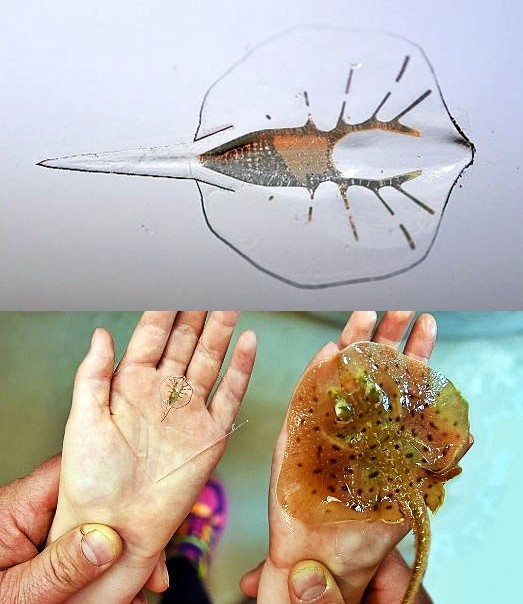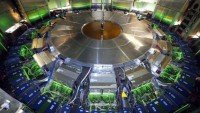Harvard Researchers Create Robotic Stingray Powered by Living Heart Muscles
| Arthur Dominic Villasanta | | Jul 08, 2016 11:21 PM EDT |
(Photo : Karaghen Hudson and Michael Rosnach) Synthetic stingray (top) and next to a small skate (bottom) for size comparison.
A minute robotic stingray the size of a nickel and powered by living muscle tissue holds out the hope the technology that created it might one day be used to create functioning human hearts.
A research team at Harvard University's Wyss Institute demonstrated their remarkable creature swimming in water and directed by bursts of blue light. They said it might be possible to build an artificial heart using some of the same techniques.
Like Us on Facebook
Their hybrid creature has a transparent body made of silicone and a simple skeleton made of gold. The ray is propelled through water by 200,000 heart muscle cells taken from a rat. The cells were genetically altered to allow the synthetic ray to follow a pair of blue lights.
The creature mimics the undulating motions of a stingray. Flapping its wing-like elastic fins, allows the ray to maneuver through an obstacle course as it follows a blue light that selectively activates its muscle cells.
Today's artificial hearts are basically mechanical pumps. The researchers said an artificial heart made from living muscle cells such as that in their synthetic stingray would behave more like a natural heart, and would be able to grow and change over time.
"I want to build an artificial heart, but you're not going to go from zero to a whole heart overnight," said Dr. Kit Parker, a bioengineer and physicist at the Wyss Institute. "This is a training exercise."
"I thought that if I could build a stingray, I might have a greater insight into how the heart is built and how it varies beat to beat."
Dr. Parker said his 20-person team was trying to replicate as much of the heart's normal functions as they possibly could with their synthetic stingray.
By building a synthetic stingray, the team could learn how to replicate the animal's ability to respond instantly to changing conditions, much like a human heart does to changing body conditions.
The hybrid created by Dr. Parker's team displays the rhythmic, undulating motion of a real stingray. Replicating that motion is one of the project's key accomplishments. It demonstrates how to use the cardiac cells that power a beating heart to operate a flexible artificial organism such as the synthetic ray.
Tagsrobotic stingray, Harvard University Wyss Institute, artificial heart, Dr. Kit Parker
©2015 Chinatopix All rights reserved. Do not reproduce without permission
EDITOR'S PICKS
-

Did the Trump administration just announce plans for a trade war with ‘hostile’ China and Russia?
-

US Senate passes Taiwan travel bill slammed by China
-

As Yan Sihong’s family grieves, here are other Chinese students who went missing abroad. Some have never been found
-

Beijing blasts Western critics who ‘smear China’ with the term sharp power
-

China Envoy Seeks to Defuse Tensions With U.S. as a Trade War Brews
-

Singapore's Deputy PM Provides Bitcoin Vote of Confidence Amid China's Blanket Bans
-

China warns investors over risks in overseas virtual currency trading
-

Chinese government most trustworthy: survey
-

Kashima Antlers On Course For Back-To-Back Titles
MOST POPULAR
LATEST NEWS
Zhou Yongkang: China's Former Security Chief Sentenced to Life in Prison

China's former Chief of the Ministry of Public Security, Zhou Yongkang, has been given a life sentence after he was found guilty of abusing his office, bribery and deliberately ... Full Article
TRENDING STORY

China Pork Prices Expected to Stabilize As The Supplies Recover

Elephone P9000 Smartphone is now on Sale on Amazon India

There's a Big Chance Cliffhangers Won't Still Be Resolved When Grey's Anatomy Season 13 Returns

Supreme Court Ruled on Samsung vs Apple Dispute for Patent Infringement

Microsoft Surface Pro 5 Rumors and Release Date: What is the Latest?













